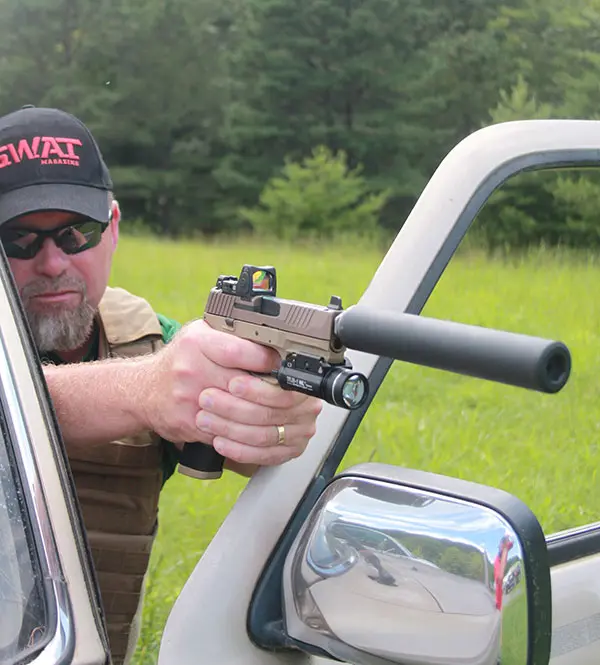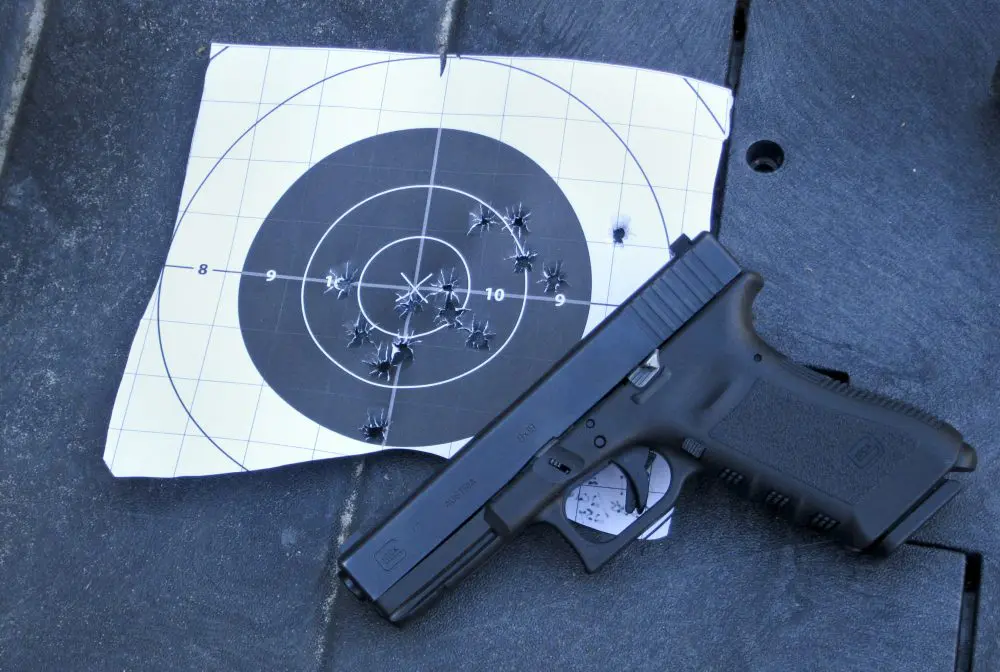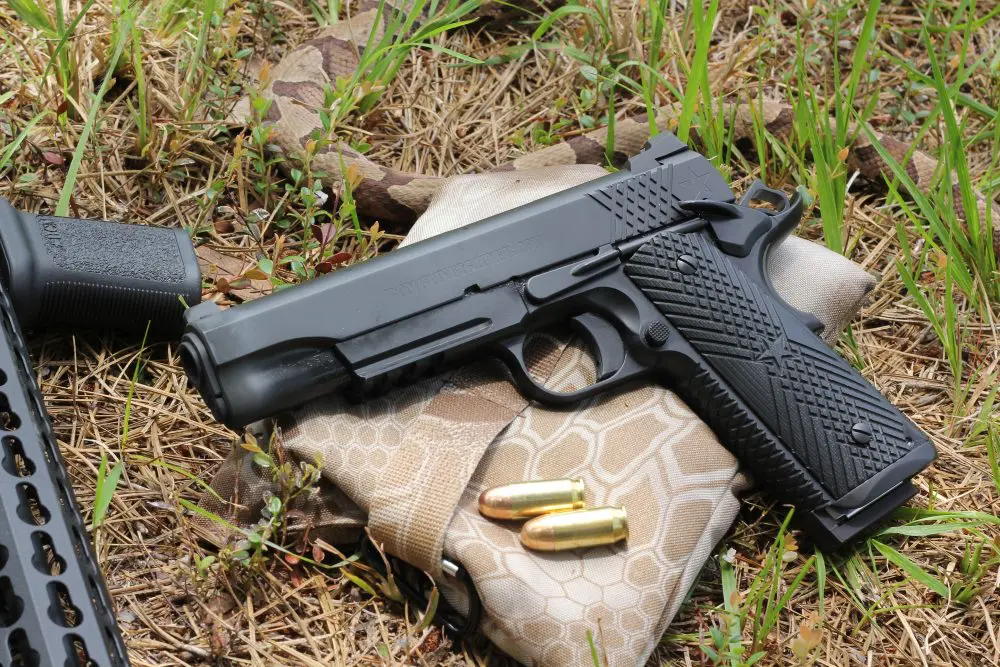
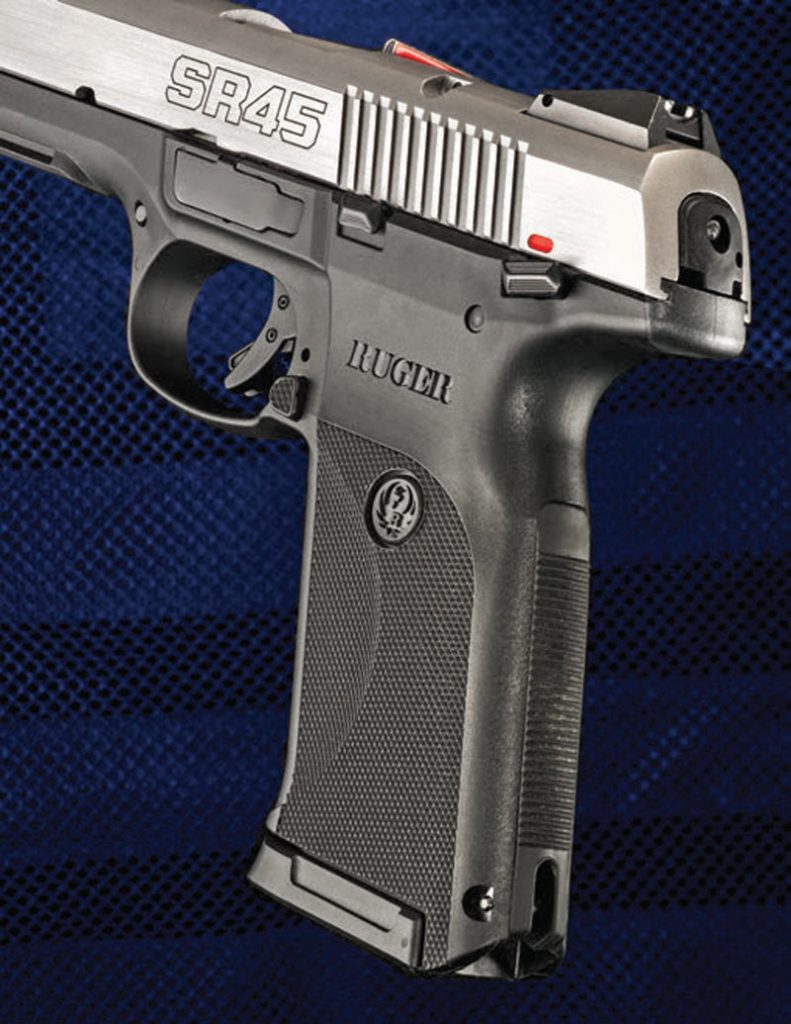
Sturm, Ruger & Co. introduced two new pistols chambered for .45 ACP at the 2013 SHOT Show. The two pistols were a Commanderstyle 1911—the SR1911CMD —and the SR45. When they arrived at my doorstep for test and evaluation, it was another one of those “I love my job” days. But would the pistols live up to my initial enthusiasm?
SR1911CMD
I was lucky enough to shoot the Ruger SR1911 before it was officially released to the public. When it was introduced, it was met with instant acclaim by 1911 aficionados. But one of the most asked questions was, “When is Ruger going to come out with a Commander type?”
The hopes of many 1911 devotees have now been realized.
The chief difference between the SR1911 and the SR1911 CMD (Commander) is the barrel length. The standard 1911 has a five-inch barrel, while the CMD has a 4.25-inch barrel.
The frame and slide are non-glare stainless steel. The sighting system is of the three-dot type. The rear sight is a Novak® LoMount and is adjustable for windage with a standard front sight. These non-snag sights are ideal for carry.
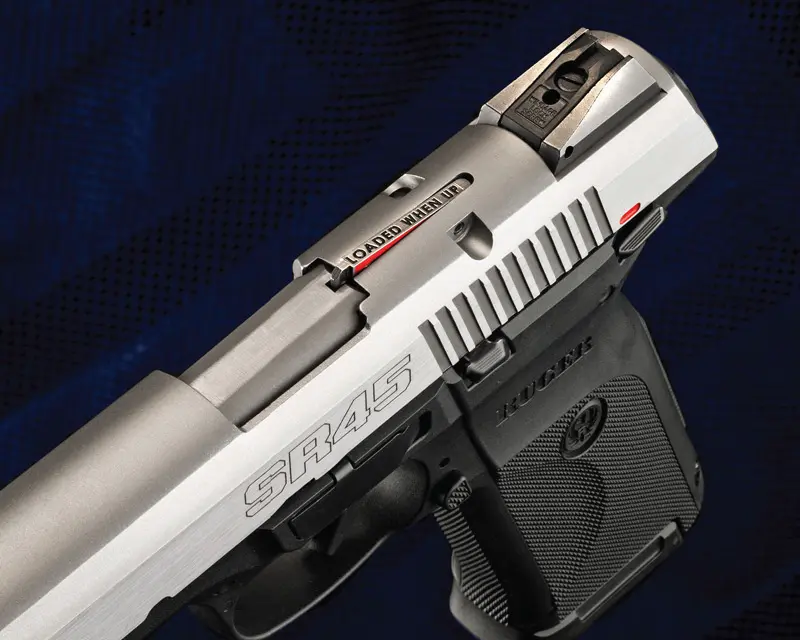
The internals are of the Series 70 type, with no firing pin safety, Browning-designed barrel bushing and standard (short) guide rod. Thank you, Ruger!
The CMD has a flat checkered mainspring housing. The magazine release is higher than a standard release with a checkered face. The thumb safety is slightly extended, but not enough to cause a concern for concealed carry. It clicks positively into both the safe and fire positions.
Both the hammer and trigger are skeletonized to reduce weight and improve lock time. The aluminum trigger has an over-travel adjustment screw.
Thanks to Ruger’s advanced CNC manufacturing, the plunger tube that holds the spring and detents for the slide lock and thumb safety is integrally machined into the frame to ensure it does not come loose.





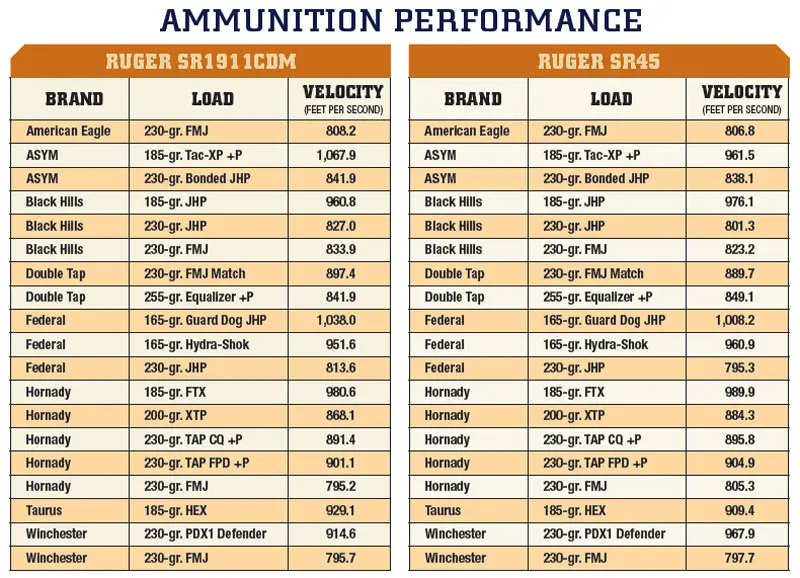
Detractors say this is a negative feature and does not allow replacement in case it becomes dented. Perhaps, but I can’t envision a scenario where the pistol is dropped so vigorously on a relatively sharp, hard surface for that to happen. On the other hand, I have seen quite a few plunger tubes come loose, requiring a new tube and then needing to have it restaked into place.
The grip safety is of the beavertail type and has a “speed bump” to guarantee it is positively disengaged.
The grip safety, thumb safety, magazine release, slide lock, mainspring housing, stock screws and all pins are finished in matte black and provide an aesthetically pleasing contrast to the stainless frame and slide.
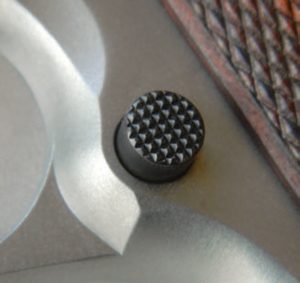
The checkered rosewood stocks feature the traditional double diamond pattern at the top and bottom, with the Ruger logo inset into the center.
The SR1911CMD ships with two seven- round magazines, bushing wrench and soft case.
SR45
Ruger’s SR45, chambered for .45 ACP, rounds out their popular series of striker- fired polymer-frame pistols, along with the 9mm and .40 S&W cartridges.
The pistol is available both with a brushed stainless slide (KSR45) and a steel frame with black nitride finish (BSR45). The test gun had the brushed stainless slide. There is a loaded chamber indicator on top of the slide that can be checked by tactile feel in low light or seen in daylight.
Like the SR9 and SR40, the pistol has a black glass-filled nylon frame. The frame is contoured in such a manner to allow a high hold to help negate muzzle flip and recoil. To fit hand sizes or preferences, the rubber backstrap is reversible—flat on one side and arched on the other—and is easily changed by pushing out a single pin.

The front of the frame has an integral rail for lights or lasers. The magazine release button is a unique “D” shape. The magazine release, slide lock and thumb safeties are ambidextrous.
The SR45 ships with two ten-round flush-fit steel magazines and a magazine- loading tool in a hard case.
FIELD EVALUATION
I received both the SR1911CMD and the SR45 just before the “Great .45 Festival” at Gunsite. This is a yearly threeday event put together for a few select writers by Dick Williams and Gunsite. As the name implies, it is for .45-caliber handguns—semi-autos and double and single-action revolvers. Double Tap ammunition furnished all the ammunition for the occasion, with Galco supplying holsters for the various pistols.

Wanting to get in some good trigger time with the two new Rugers, I did not shoot any revolvers and stuck to the two semi-autos throughout the three days.
Range drills for both pistols at Gunsite and later were conducted with Galco holsters. For the SR1911CMD, Galco’s Avenger holster was used, while the SR45 was tested with the hybrid Kydex®/leather TacSlide™ holster. Galco’s DMP double magazine pouches were used with both pistols, in conjunction with Galco gun belts.
The TacSlide holster that fits the SR9 and SR40 also fit the SR45—a testament to the fact that Ruger kept the larger caliber handgun as slim as possible.
Trigger pull on the SR1911CMD, as predicted for a 1911, was very good, breaking cleanly at 4.9 pounds with no overtravel and a positive reset.
What I didn’t expect was the trigger on the SR45. It has been my experience that the trigger on some striker-fired pistols feels, for lack of a better word, “spongy.” Not so with the SR45. It was very crisp and let off at 5.2 pounds.
While the SR1911CMD comes with a bushing wrench, I was very happy that it was not needed to field strip the pistol during the evaluation. This is one reason I prefer the original guide rod to a full-length guide rod.
On the other hand, the magazine loader that comes with the SR45 came in handy. While all ten rounds can be loaded by hand, until the springs took a bit of set, the last two rounds were hard to load without the assistance of the loader.

At the Gunsite event, I put about 200 rounds downrange through each pistol. I had two failures to fire with each. Both malfunctions were a failure to go into battery, and both occurred within the first 50 rounds. No problems of any kind were experienced after that.
Back on my home range, I assembled 19 different factory loads from seven manufacturers. Each load was fired in ten-round strings to determine the average velocity of each load using a PACT Professional model chronograph.
As expected, there was very little difference between the SR1911CMD’s 4.25-inch barrel and the SR45’s 4.5-inch barrel in respect to velocity, with some loads clocking faster in the 1911 and some faster in the SR45. I was pressed to get the pistols to S.W.A.T. Photographer Robbie Barrkman in time for deadline, so I did not bench either for accuracy.
However, I put a total of about 800 rounds through both in range drills and found them more than accurate enough for a fighting pistol. From 15 yards, rounds would typically group at 2.5 to 3 inches firing fast dedicated pairs. Out at 25 yards, both pistols were easily capable of keeping all rounds within six inches from standing.
A friend did bench an SR45 and was able to keep all rounds within three inches at 25 yards. In all honesty, if you need more accuracy than that, you need a rifle.
Like all Ruger firearms, both the SR1911CMD and SR45 represent very good bargains. I would not hesitate to go in harm’s way with either—though of course I’d prefer to take both.
